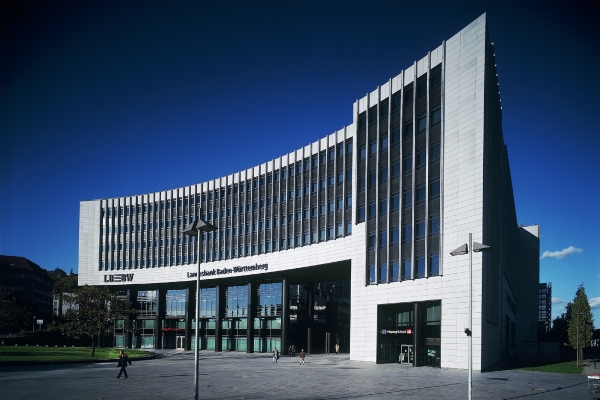LBBW in quick green SNP return as levels tighten
Landesbank Baden-Württemberg issued its third green bond in just over two months on 17 July, a EUR500m no-grow seven year senior non-preferred issue priced flat to where the German bank sold a EUR750m five year SNP transaction in mid-May.
After having updated its green bond framework, LBBW sold the senior non-preferred green bond on 15 May, and then issued the first green covered bond in US dollars, a $750m (EUR672m) three year mortgage Pfandbrief, on 21 May.
On 17 July, the bank then returned to the market, announcing a EUR500m no-grow senior non-preferred seven year green bond, with leads Crédit Agricole, DZ, HSBC, LBBW and Nordea going straight out with initial price thoughts of the 65bp over mid-swaps area. The deal was priced at 53bp over mid-swaps, with around EUR850m or orders good at re-offer, excluding JLM interest, after the book had peaked above EUR900m with over 100 accounts based on guidance of the 55bp area.
The spread of 53bp — and indeed the IPTs and guidance — matched that of LBBW’s earlier, EUR750m five year, given the performance of the market in the interim. The May 2024 issue was quoted 10bp tighter, at 43bp, mid, at the time of the seven year’s launch.
“Since the beginning of June we have seen spreads tightening and the market being very constructive,” said Patrick Steeg, head of asset and liability management at LBBW (pictured). “We received quite a lot of recommendations and pricings at the same level as the five year, and saw this as the perfect opportunity to further build our non-preferred curve.”
Following the new issue, LBBW has senior non-preferred benchmarks outstanding maturing in 2021, 2022, 2024 and 2026.
“We now have a nice senior non-preferred curve,” said Steeg (pictured), “with three of the four in green format. It is our ambition that whenever we come to the market in benchmark format, it should be in green — or in the near future, social — format.”

According to the leads, around 60% of the new issue was allocated to investors deemed green, including many names new to LBBW’s issuance.
“The green aspect really makes a difference,” said Steeg. “We had a granular book that was very well diversified by investor type as well as geographically.”
Some 64% of the deal was allocated to German and Austrian investors, with France taking 20%, Switzerland 4%, Asia 4%, the Nordics 3%, the Benelux 2%, southern Europe 2%, and the UK and Ireland 1%. Funds took 39%, banks 31%, insurance companies and pension funds 21%, and central banks and official institutions 9%.
According to Steeg, French participation was higher than for LBBW’s other green bonds, which he said was notable given how tight the bank trades relative to international peers. The longer, seven year maturity was also cited as a factor helping lift French demand, while Vincent Hoarau, head of FI syndicate at joint lead Crédit Agricole CIB, said it was partly a pay-off from more pronounced marketing of the credit in France, with investor meetings having taken place in Paris ahead of the Tier 2, for example.
“This transaction shows further evidence of the traction provided by the green element while valuations are fairly rich,” said Hoarau (pictured). “Drops were pretty limited on the pricing revision, while the deal performed off the break in the secondary market. We are trading the bonds in the high 40s over swaps.”

The book for LBBW’s latest green bond was lower than on its previous issues, but the trade is also the bank’s smallest green bond yet, and Steeg noted that the size was limited to EUR500m from the outset, with pricing then the focus during execution.
“We are very happy with the outcome,” he added.
The lead syndicate banker said the pricing was roughly 1bp-2bp over fair value of 50bp to the low 50s over mid-swaps, depending on how the curve is viewed.
The green bond is LBBW’s fifth since it debuted in December 2017, taking its outstandings to some EUR3.2bn-equivalent.
“The framework appears to be quite well established,” said Peter Kammerer, head of investor relations at LBBW. “It seems investors have understood our strategy from the recent transactions, which met with good demand and have performed well.”
In between issuing a EUR500m covered bond in June 2018 and its three latest green bonds, LBBW added UK commercial real estate to the energy efficient buildings part of its framework that already included German and US properties, and initiated renewable energy projects (wind and solar) as an eligible category for use of proceeds. Energy efficient buildings constituted EUR4.6bn of LBBW’s green bond portfolio and renewables EUR1.3bn, with the portfolio growing from EUR2.7bn at the end of 2017 to EUR5.9bn at the end of 2018, making it the second largest such portfolio in Germany.
“It’s a major step forward,” said Kammerer. “The eligibility criteria are also now stricter than before and the reporting more accurate.”

